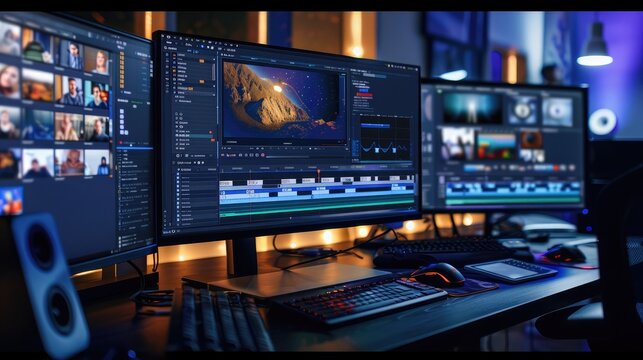
From Script to Screen: The World of Video Production
Video production is a powerful medium that bridges creativity and technology to tell stories, promote products, educate audiences, and inspire emotions. Whether for marketing, entertainment, education, or personal expression, the process of creating a video requires a mix of technical skills, artistic insight, and a well-planned strategy. This comprehensive guide will take you through the essential steps, techniques, tools, and best practices for mastering the art of video production. Video production is a multifaceted process that combines technical skills, creative vision, and strategic planning to produce compelling visual content. Whether for marketing, training, entertainment, or personal projects, video production encompasses various stages, from conceptualization to distribution. This comprehensive guide delves into the intricacies of video production, covering essential techniques, equipment, and best practices to help you create high-quality videos.
The Table of Contents of Video Production 
Introduction to Video Production: Video production is more than just recording a sequence of images; it's the art of storytelling through motion, sound, and visuals. In today's world, video content is ubiquitous, powering platforms like YouTube, TikTok, and Instagram, and forming the backbone of television and film. Videos can serve multiple purposes: they can entertain, inform, educate, and persuade. The video production process can be divided into three main phases: pre-production, production, and post-production. Each of these phases is critical in transforming an initial idea into a polished, professional video.
Pre-Production: Planning Your Video: The foundation of any successful video project lies in thorough pre-production. This phase is all about planning every aspect of the video before filming begins, ensuring the vision is clear, the budget is set, and the team is prepared.
- Concept Development: The concept is the heart of the video. It is the core idea that the video will convey, whether it's a story, a promotional message, or an educational piece.
- Scriptwriting: Once the concept is in place, it’s time to write the script. The script is a blueprint for the video, detailing everything from the dialogue to scene descriptions. A well-written script gives direction to the actors and production team and ensures that the message is conveyed effectively.
- Storyboarding: Storyboarding involves creating a visual representation of the video’s script. Each scene or shot is illustrated, detailing camera angles, framing, and any specific actions that will take place. This visual guide is invaluable for ensuring everyone on set knows exactly what shots are needed.
- Budgeting: Creating a budget for the video is a critical part of pre-production. Every aspect of production, from actors to equipment, must be accounted for. Video production costs can vary significantly based on factors like location, crew size, equipment needs, and post-production requirements.
- Scheduling: Finally, scheduling the shoot ensures that the production phase runs smoothly. Scheduling includes locking down shoot dates, booking talent, and coordinating with the crew. A detailed production schedule should outline the time needed for each scene, transitions between locations, and breaks.
Production: Capturing the Vision: The production phase is where all the planning from pre-production comes to life. This is the part where the video is shot and all footage is collected.
- Cameras and Equipment: Selecting the right camera is crucial. While smartphone cameras have come a long way, professional productions typically rely on DSLRs, mirrorless cameras, or cinema-grade cameras. Key factors to consider include resolution, frame rate, and sensor size. Additional essential equipment includes Tripods and Stabilizers, Lenses, Drones.
- Lighting Techniques: Lighting is critical in creating the mood and tone of your video. Good lighting can drastically improve the quality of the footage, while poor lighting can make even the best shot look amateurish. Some of the most common lighting setups include: Three-Point Lighting, Natural Lighting, Soft and Hard Lighting.
- Audio Recording: Sound is just as important as visuals in video production. Poor audio quality can ruin even the most visually stunning video. To capture high-quality sound, you’ll need to use professional microphones, such as Boom Microphones, Lapel Microphones, Directional Microphones.
- Directing and Performance: The director plays a vital role in ensuring that the vision is executed on set. They guide the talent, manage the crew, and make creative decisions in real-time. Good communication between the director, actors, and crew ensures that everyone is aligned with the project's objectives.
- Framing and Composition: Composition refers to how the subjects are framed within the shot. It is about guiding the viewer's eye to the most important part of the scene and creating aesthetically pleasing images. Some rules and techniques include: The Rule of Thirds, Symmetry, Leading Lines.
- Editing Process: The editor's job is to assemble the footage into a coherent and compelling story. This involves selecting the best takes, trimming shots, and arranging them in a way that maintains pacing and continuity. Editing software like Adobe Premiere Pro, Final Cut Pro, and DaVinci Resolve are widely used in the industry.
- Color Grading: Color grading enhances the visual style of the video by adjusting the color palette. It can be used to create different moods, establish continuity between shots, or correct any color issues that occurred during filming. Software like DaVinci Resolve offers advanced tools for professional color correction and grading.
- Sound Design and Music: Sound design involves adding and enhancing sound effects to complement the on-screen action. This can include everything from footsteps to ambient noise. Music, on the other hand, sets the emotional tone of the video. Whether it’s a score composed for a film or a licensed track, the right music can elevate the viewer’s experience.
- Visual Effects (VFX): Visual effects are used to create elements in the video that are either impractical or impossible to film. VFX can range from simple things like screen replacements to complex animations and CGI. Software like Adobe After Effects is widely used to add special effects to a video
- Titles and Graphics: Text elements such as titles, lower thirds (used in interviews), and credits are added during post-production. Graphics and animations, such as company logos or motion graphics, can also be integrated to give the video a professional feel.
- Choosing the Right Platforms: Different platforms cater to different types of content and audiences. YouTube, for example, is great for longer videos, while Instagram and TikTok are ideal for short-form content. For business purposes, platforms like LinkedIn and Vimeo may be more suitable. YouTube, Instagram and TikTok, Vimeo.
- Optimizing for SEO: For your video to gain visibility, it must be optimized for search engines. This involves using the right keywords in the title, description, and tags, as well as choosing the right thumbnail and adding subtitles. Title, Description, Tags.
- Creating Thumbnails and Titles: The thumbnail and title of a video are often the first things a viewer sees. They play a significant role in enticing viewers to click on the video. A well-designed thumbnail should be visually engaging and representative of the content, while the title should be catchy and to the point.
Trends in Video Production: As technology continues to evolve, so do trends in video production. Staying updated with the latest trends can keep your content fresh and relevant.
- Virtual Reality (VR) and 360-Degree Video: VR and 360-degree videos offer immersive experiences, allowing viewers to explore an environment from all angles. This technology is increasingly used in tourism, real estate, and educational content, providing users with a more interactive experience.
- Live Streaming: Live streaming has become a powerful tool for brands, influencers, and content creators. It allows real-time engagement with audiences, which is perfect for events, product launches, or Q&A sessions. Platforms like YouTube Live, Facebook Live, and Twitch have made live streaming accessible to anyone with a camera and internet connection.
- Interactive Video: Interactive videos allow viewers to engage with the content by making choices that influence the storyline. This is particularly popular in educational content, gaming, and marketing, as it keeps viewers engaged and offers a personalized experience.


Leave a Comment